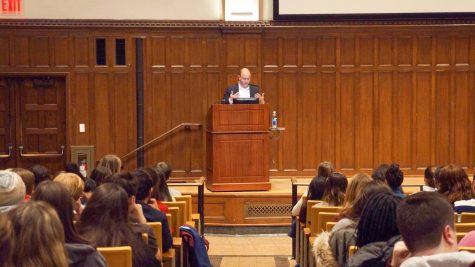New York Botanical Garden Prepares for Winter Season
Juliana Esoldi/ The Fordham Ram
The New York Botanical Garden looks forward to flowers such as witch-hazels, snowdrops and paperbush flowering in the winter.
October 16, 2019
As temperatures drop and New Yorkers start donning their jackets, the New York Botanical Gardens (NYBG) has a few things to do to protect their plants from the cold.
Adam Choper, the Margorie G. Rosen Manager of Outdoor Gardens, said the NYBG is busy preparing for the winter ahead.
“We make sure our not-so-cold hardy plants that were out on display are safe and snug in our greenhouses for the winter,” he said. “We also do a lot of work preparing beds for the following season by top dressing with leaf mulches or composts that will be broken down by soil micro-organisms and will feed next year’s growth.”
In NYBG greenhouses, employees are starting to plant seeds and cuttings that will be used for the coming summer season, and outdoors, they are taking the opportunity to prune and shape some of their woody plants as winter is an ideal time for such updates, according to Choper.
Choper said most visitors assume that gardens don’t bloom during the colder months, but the changing of the seasons is one of his favorite parts about gardening, precisely because of the variation in the types of blooms. Plants like witch-hazel, snowdrops and paperbush all flower in the winter, and many plants have interesting forms and barks that are best appreciated in the colder months, according to Choper.
Choper’s favorite part about winter in the NYBG are the trees —both the deciduous trees that drop their leaves as well as the Benenson Ornamental Conifer Collection that keeps theirs.
“In the winter, you really get to see the architecture and bones of the gardens in ways that you cannot necessarily in the middle of summer,” he said. “Each garden at NYBG is carefully laid out so that there are four seasons of interest.”
Angela Torricella, FCRH ’23, said she will miss seeing the rose garden in full bloom most.
“I’m really excited to see what they have in store for winter though, and I’m curious to see if they have any special winter exhibits, like the Bronx Zoo does,” she said. “I expect it takes a substantial amount of effort into transitioning to the winter.”
Juliane Pautrot, FCRH ’23, seconded Torricella’s appreciation for the gardens.
“I really loved all the flowers blooming so I will definitely miss those in the winter,” she said.
Pautrot has visited the gardens with the Halloween exhibit on display, and said she is looking forward to how they will top that experience.
“I can’t wait to see how they will decorate for Christmas and the winter,” she said. “I’m guessing it takes a lot of work – not only do they have to keep all the plants healthy, [but] they also have to design decorations, put them up, plan events, and I’m sure there is more.”
NYBG additionally runs the Edible Academy program through the fall and winter seasons. “Dig! Plant! Grow! Goodnight, Garden” is the current program, running from Oct. 15, 2019, through Nov. 3, 2019. Its focus is on growing, caring for, harvesting and preparing fruit sand vegetables.
Also taking shape at the NYBG is the annual Train Show, in its 28th year this year. This year’s theme is Central Park, and it will run from Nov. 23, 2019 through Jan. 26, 2020.
Laura Busse-Dolan, president and CEO of Applied Imagination, said that the NYBG chose to depict Central Park this year as a way to showcase and expand the work done in previous years.
“Central Park stood out as a collection that we could not only take a little bit further with the buildings that needed to be redone, but also with the buildings that maybe weren’t represented previously [in the show],” she said.
Some such buildings include the Belvedere Castle, the Plaza Hotel, the Metropolitan Museum of Art and the American Museum of Natural History, among others. All of the landmarks featured in the display will be crafted from natural materials like bark, twigs and fruit.
Since the Palm Dome is currently undergoing restoration, the display will be in a new location: the Conservatory Lawn, adjacent to the Enid A. Haupt Conservatory. Busse says that this will serve as an “opportunity to reinvent the way that all of these New York icons are displayed amongst our trains.”
The NYBG’s holiday season traditions will be on display in the coming months. Tickets for the Train Show are available at a 30% discount until Nov. 1, 2019 at nybg.org. Tickets for “Dig! Plant! Grow! Goodnight, Garden” are also available at nybg.org.












If you want a picture to show with your comment, go get a gravatar.